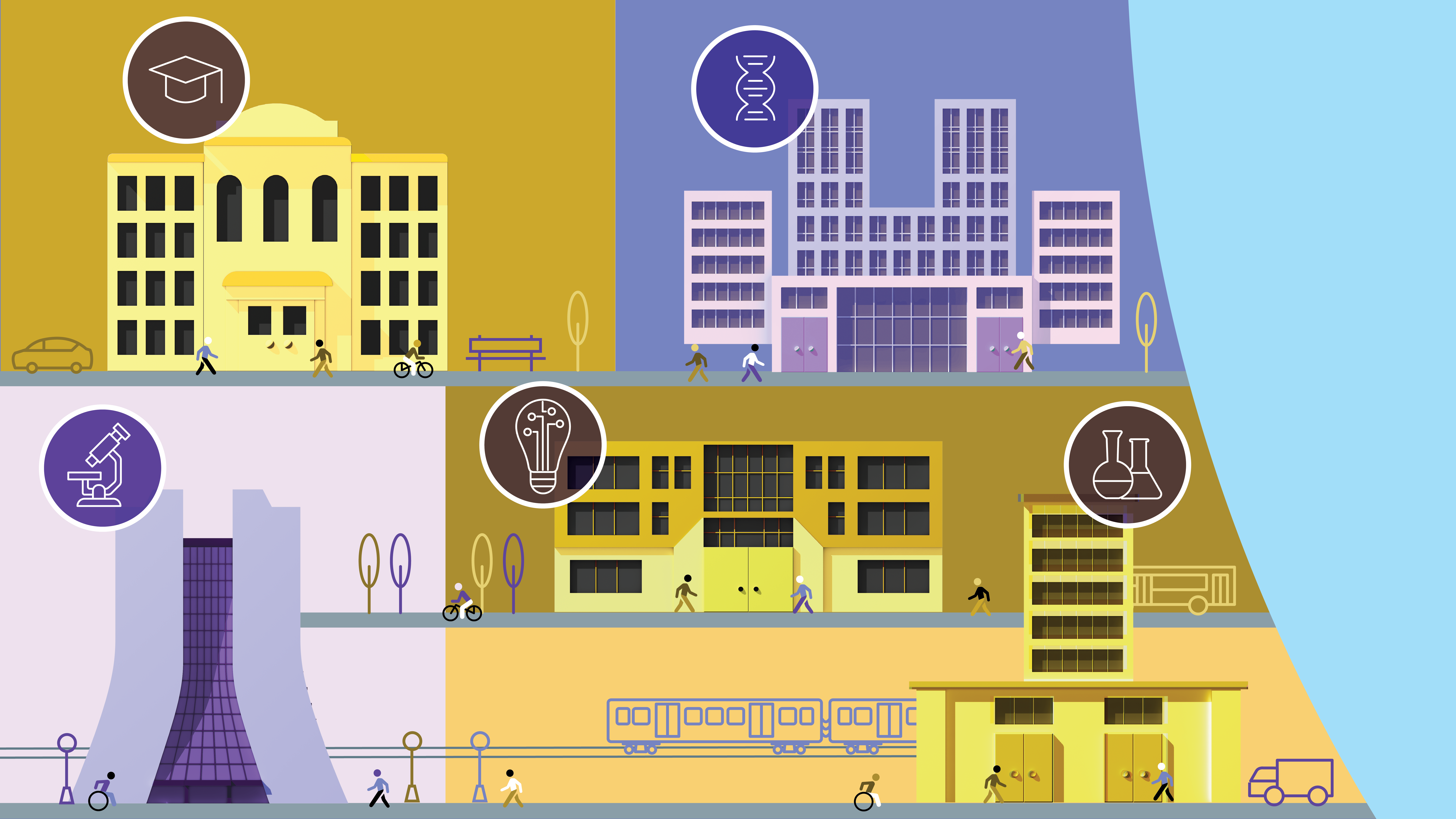Recommendation
Enhance economic innovation
As the global economy evolves, sustainable and resilient growth increasingly depends on metropolitan Chicago’s capacity to convert new ideas into higher productivity and greater competitiveness. Public strategies can create the conditions for such innovation to fuel longer, more sustained, and inclusive economic growth. Despite its many economic assets, key ON TO 2050 indicators like patenting and venture capital activity suggest that the region lags behind peers in terms of research, commercial development, and entrepreneurial activity.
Strategies
Innovation can take many forms and occurs throughout the economy. Rapid technological changes are often the most prominent examples, such as recent advances in artificial intelligence, advanced materials, and the digitalization of services. New, unforeseeable industries can arise as these breakthroughs find applications throughout the economy. However, other forms of innovation can also generate important economic benefits, such as better ways of operating a business. More subtle process innovations can help businesses reduce errors or costs, increase output, and improve quality, speed, and functionality. For example, advances in data analytics have allowed businesses to reorganize production and distribution, finding new efficiencies. Based on recommendations of the GO TO 2040 plan and subsequent analysis, CMAP’s policy and planning work aims to support the full range of innovative and entrepreneurial activities that contribute to economic vitality.
Innovation necessarily begins with strong investments in human capital, which will always be the region’s source of next-generation ideas and its strongest competitive advantage. An inclusive, high quality labor force spurs innovation in two ways: by developing more innovative ideas and by implementing those ideas more readily. Innovation from the region stands to benefit from diversifying the voices contributing to their development. At the same time, the diffusion of new technologies and processes requires mobilizing our full inventive talent at all skill levels. As new innovations find uses throughout the economy, workers in most occupations and at all skill levels will need to be equipped to use them to accomplish a wide range of creative and problem-solving tasks.

Because the private sector is a key driver of innovation and commercialization, the role of the public sector is to find ways to help spur innovation by supporting institutions, relationships, and the essential components of a modern economy. Policies and programs should focus primarily on supporting dense, dynamic economic activity in the Chicago region and ensuring that different, diverse parts of the region can participate. ON TO 2050 emphasizes entrepreneurial growth and the adoption of innovations among incumbent businesses, while acknowledging the vital role and importance of new idea generation and development. CMAP continues to support the work of other organizations striving to improve our region’s position at the cutting edge of scientific, technological, artistic, and commercial breakthroughs.
The following describes strategies and associated actions to implement this recommendation.
Leverage institutions of higher education and research for economic development
While their primary output is talent and not technology, universities and community colleges have extensive resources to support economic growth through fostering development, retention of viable commercial startups, and local efforts to build inventive talent. Many R&D-intensive firms benefit from proximity to institutional assets like specialized research, data resources, analytical and faculty expertise, and business counseling services. The region’s national laboratories and other research institutions likewise offer exceptional opportunities for economic development. As strategies for regional growth take shape, CMAP and partners should draw on unique assets not present in other regions and connect them to regional firms and investors. This should include higher rates of research and development investments, higher rates of new business formations, and the diffusion and commercialization of innovations among existing businesses.
Pursue strategies to connect the region’s national labs, universities, and other research institutions to market opportunities with regional firms and investors.
Support institutions and relationships that provide services to small and medium-sized enterprises lacking access to their innovation ecosystems and financing.
Provide robust and reliable public funding for higher education, which is crucial for cultivating, retaining, and attracting innovative talent and businesses to northeastern Illinois.
State of Illinois
Diversify the entrepreneurial voices engaged in problem and solution development
Today, metropolitan Chicago limits its own innovative capacity when it fails to expose many residents to a culture of innovation and to invest in their education, skills acquisition, and entrepreneurship. Research demonstrates that even high-aptitude students from lower income and diverse backgrounds are impeded from participating in innovation and invention. A U.S. Department of Commerce report also found that minority-owned businesses receive fewer, smaller, and more expensive loan and equity investments than non-minority businesses. Without more investment in the region’s human capital and deliberate steps to ensure financial inclusion, these drains on productivity will continue to hinder the region’s economic growth. An analysis by the Federal Reserve Bank of Cleveland showed that racial and ethnic diversity, openness to immigrants, and low rates of racial segregation contribute to growth in employment and productivity. Put simply, strategies for inclusive growth will broaden the pool of creative talent and market-driven inventions available to businesses. Exposing diverse residents to successful entrepreneurs and the so-called “opportunities of failure” can create a fertile environment for innovation in all areas of the region.
Improve access to capital, science, technology, engineering, arts, and mathematics education, and training opportunities for residents of EDAs.
Innovation ecosystem, such as investors, institutions of higher education and research, and technical service providers
Provide mentorship, internship, apprenticeship, and other opportunities that ensure all residents with an aptitude for invention are exposed to a culture of innovation.
Innovation ecosystem, such as startup incubators, accelerators, institutions of higher education and research, and private businesses
Reorient policies to better support innovation and entrepreneurship
Both the quality of an innovation and the extent to which it is used determine the impact it will have on the economy. Economic innovation requires both conceiving new ideas and adapting them into the technologies, processes, business models, and industries that bring improved goods and services to market. Some innovations find expression in entirely new offerings or startups, while others manifest as new efficiencies and business expansion. As a result, the innovations that enable growth are generated by the private sector but can be supported through public policy. Research continues to refine how the public sector can best support an innovation and entrepreneurship system. At root, innovation is the product of vibrant economic activity, a robust business environment, and high quality human capital. Broad economic development can help to align and improve existing initiatives to create value through the innovation process.
Policies and programs regarding economic innovation frequently focus more on spurring new ideas than on expanding their diffusion and adoption. Customary strategies include support for basic scientific research, intellectual property rights, access to capital, and commercial development. Continuous improvement in these areas remains important. However, other local and regional strategies can build on this foundation to leverage new innovations for global competitiveness. For a wave of innovation to drive economic growth, advances need to spread across multiple sectors, attract additional business investment, and translate into higher productivity. Resources and policies for economic development should be tailored to support the efforts of viable young companies attempting to scale up and the adoption of innovations among incumbent businesses. Local and state officials should consider overall economic gains and regional goals in assessing the appropriateness of plans, policies, and programs regarding innovation. Some state policy reforms may be necessary to promote competitiveness, such as changes in regulations regarding non-disclosure or non-compete agreements. The variety of these supports and their effectiveness is significant. CMAP and partners should continue to serve as a resource for information and analysis on regional economic performance, existing resources that support our innovative capacity, and best practices to support industry innovators.
Identify and communicate stronger metrics for tracking innovation
Sound measurement of innovation is crucial for evaluating the efficiency of public policies and programs, and assessing their contribution to achieving regional goals. Yet the data currently available cannot adequately account for the full role innovation and entrepreneurship play in today’s economy. Numerous metrics have been developed to help regions position their innovative capacity relative to peers. These indicators typically focus on inputs to idea generation, such as R&D expenditures, venture capital, and STEM jobs. Due to data access and quality problems, measurements of outcomes -- the economic value of new-to-market or new-to-firm innovations -- remain underrepresented. The use of indicators overly focused on inputs can lead local and regional stakeholders to overlook the importance of rapid technology adoption and other more subtle forms of innovation. In support of performance-based approaches, CMAP and partners should develop additional information regarding public investments, regional industry trends, and economic outcomes.
